Navigation
Menu
They can be "native" - where the entire construction of the database from storage, management and query is based on the graph structure of the data. The relationships between entities are then data in their own right.
Either they use more traditional database constructs, (e.g. tables), and then have a Graph API layer on top

The graph is a mathematical model used to describe the relationships between entities. However, each complex network has intrinsic properties.
Properties are measured using specific metrics
No
Yes